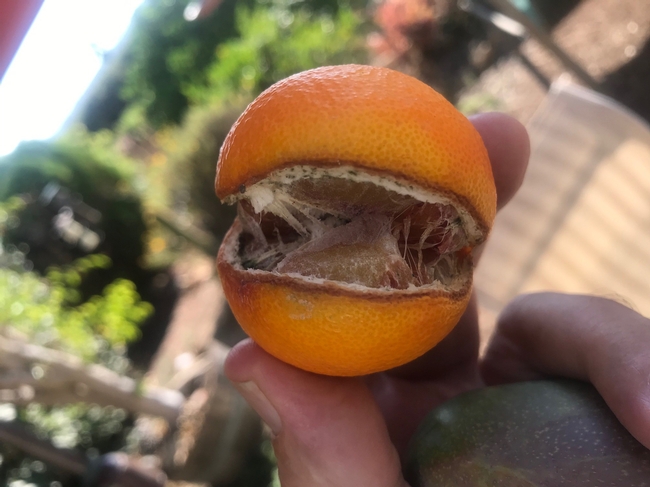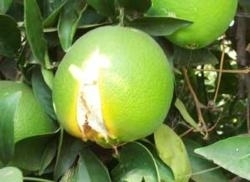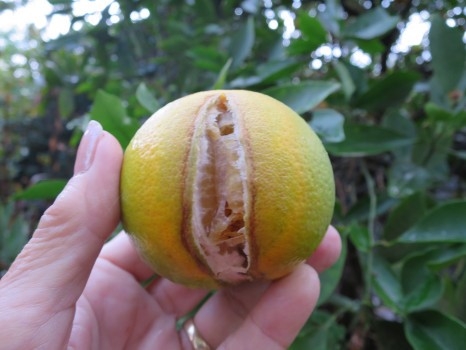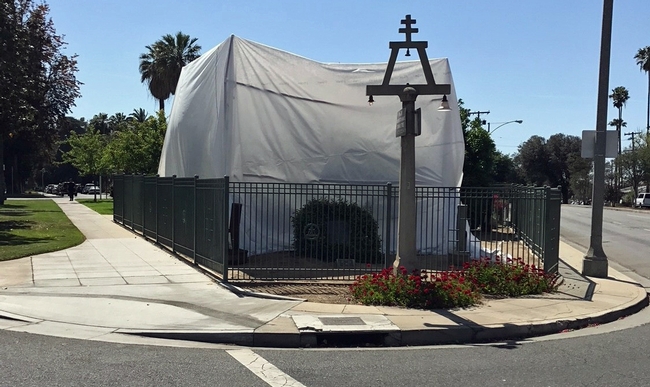
Posts Tagged: navel
Citrus Splitting
It has been a struggle to get through the summer this year. Weird. Hot. Then fog in August. Hot. Then fog in October. It's supposed to be clear,, blue skies in October. perfect weather for avocado persea mite and citrus leaf miner. Hot times then cooler. How to irrigate? A lot of folks just decided not to irrigate. Why do it when it's so crazy? Forecast was for no rain, but it's cool. And then it rained, and suddenly that beautiful citrus that has just broken color and is an orange globe, splits. It's most common in navels, but all citrus that ripen in the fall – tight-skinned satsuma mandarins, early clementines, tangelos and blood oranges. With the hot summer, it seems that a lot of citrus fruit have accelerated their maturity and are ready, ripe and sweet right now, and maybe ready to split.
And that's the problem. Drought stress. Salt stress due to drought. Water stress due to miserly watering. A heat wave in July. And a weird fall with maybe rain and maybe no rain and is ¼ inch considered rain or just a dedusting? Irregular watering is the key to splitting this time of year. The sugar builds, the pressure to suck in water builds and the fruit has been held back by a constrained water pattern and suddenly some water comes and it goes straight to the fruit and Boom, it splits.
Years of drought, and a stressed tree are a perfect set up for a citrus splitting in fall varieties like navel and satsuma. The days have turned cooler and there's less sense on the part of the irrigator to give the tree water and suddenly out of nowhere, there is rain. That wonderful stuff comes down and all seems right with the world, but then you notice that the mandarin fruit are splitting. Rats? Nope, a dehydrated fruit that has taken on more water than its skin can take in and the fruit splits. This is called an abiotic disorder or disease. However, it's not really a disease, but a problem brought on by environmental conditions. Or poor watering practices.
Fruit that is not yet ripe, like ‘Valencias' and later maturing mandarins are fine because they haven't developed the sugar content and have a firmer skin. They then develop during the rainy season when soil moisture is more regular. Or used to be more regular. With dry, warm winters this may become more or a problem in these later varieties, as well.
Several factors contribute to fruit splitting. Studies indicate that changes in weather, including temperature, relative humidity and wind may exaggerate splitting. The amount of water in the tree changes due to the weather condition, which causes the fruit to shrink. Then with rewetting, the fruit swells and bursts. In the navel orange, it usually occurs at the weakest spot, which is the navel. In other fruit, like blood orange, it can occur as a side split, as seen in the photo below.
Proper irrigation and other cultural practices can help reduce fruit spitting. Maintaining adequate but not excessive soil moisture is very important. A large area of soil around a tree should be watered since roots normally grow somewhat beyond the edge of the canopy. Wet the soil to a depth of at least 2 feet, then allow it to become somewhat dry in the top few inches before irrigating again. Applying a layer of coarse organic mulch under the canopy beginning at least a foot from the trunk can help moderate soil moisture and soil temperature variation.
Once split, the fruit is not going to recover. It's best to get it off the tree so that it doesn't rot and encourage rodents.
(Photo by Ottillia “Toots” Bier, UCR)

navel split
Not Just Navels Split
It has been a struggle to get through these hot times and now it's getting cooler, it's even rained, and suddenly that beautiful citrus that has just broken color and is an orange globe splits. It's most common in navels, but all citrus that ripen in the fall – tight-skinned satsuma mandarins, early clementines, tangelos and blood oranges. With the hot summer, it seems that a lot of citrus fruit have accelerated their maturity and are ready, ripe and sweet right now, and maybe ready to split.
And that's the problem. Drought stress. Salt stress due to drought. Water stress due to miserly watering. A heat wave in July. And a weird fall with maybe rain and maybe no rain and is ¼ inch considered rain or just a dedusting? Irregular watering is the key to splitting this time of year. The sugar builds, the pressure to suck in water builds and the fruit has been held back by a constrained water pattern and suddenly some water comes and it goes straight to the fruit and Boom, it splits.
Years of drought, and a stressed tree are a perfect set up for a citrus splitting in fall varieties like navel and satsuma. The days have turned cooler and there's less sense on the part of the irrigator to give the tree water and suddenly out of nowhere, there is rain. That wonderful stuff comes down and all seems right with the world, but then you notice that the mandarin fruit are splitting. Rats? Nope, a dehydrated fruit that has taken on more water than its skin can take in and the fruit splits. This is called an abiotic disorder or disease. However, it's not really a disease, but a problem brought on by environmental conditions. Or poor watering practices.
Fruit that is not yet ripe, like ‘Valencias' and later maturing mandarins are fine because they haven't developed the sugar content and have a firmer skin. They then develop during the rainy season when soil moisture is more regular. Or used to be more regular. With dry, warm winters this may become more or a problem in these later varieties, as well.
Several factors contribute to fruit splitting. Studies indicate that changes in weather, including temperature, relative humidity and wind may exaggerate splitting. The amount of water in the tree changes due to the weather condition, which causes the fruit to shrink. Then with rewetting, the fruit swells and bursts. In the navel orange, it usually occurs at the weakest spot, which is the navel. In other fruit, like blood orange, it can occur as a side split, as seen in the photo below.
Proper irrigation and other cultural practices can help reduce fruit spitting. Maintaining adequate but not excessive soil moisture is very important. A large area of soil around a tree should be watered since roots normally grow somewhat beyond the edge of the canopy. Wet the soil to a depth of at least 2 feet, then allow it to become somewhat dry in the top few inches before irrigating again. Applying a layer of coarse organic mulch under the canopy beginning at least a foot from the trunk can help moderate soil moisture and soil temperature variation.
Once split, the fruit is not going to recover. It's best to get it off the tree so that it doesn't rot and encourage rodents.

blood orange split
Ready! Set! Split! Navel Orange Time.
These are hard days for navel oranges. Drought stress. Salt stress due to drought. Then a heat wave in July that messed the trees up. And now we head into a weird fall with maybe rain. Maybe no rain. Maybe a little rain. This is ripe for navel splitting. This time of year when they are starting to build sugar, they are also ripe for splitting.
Years of drought, and a stressed tree are a perfect set up for navel oranges and fruit splitting.
The days have turned cooler and suddenly out of nowhere there is rain. That wonderful stuff comes down and all seems right with the world, but then you notice the navel fruit are splitting. Rats! No, a dehydrated fruit that has taken on more water than its skin can take in and the fruit splits. This is called an abiotic disease. Not really a disease but a problem brought on by environmental conditions.
Fruit splitting is a long-standing problem in most areas where navel oranges are grown. In some years, the number of split fruit is high; in other years it is low. Splitting in navel oranges usually occurs on green fruit between September and November. In some years, splitting may also occur in Valencia oranges but it is less of a problem than in navel oranges.
Several factors contribute to fruit splitting. Studies indicate that changes in weather including temperature, relative humidity and wind may have more effect on fruit splitting than anything else. The amount of water in a citrus tree changes due to weather conditions and this causes the fruit to shrink and swell as water is lost or gained. If the water content changes too much or too rapidly the rind may split. In navel oranges the split usually occurs near the navel, which is a weak point in the rind.
Proper irrigation and other cultural practices can help reduce fruit splitting. Maintaining adequate but not excessive soil moisture is very important. A large area of soil around a tree should be watered since roots normally grow somewhat beyond the edge of the canopy. Wet the soil to a depth of at least 2 feet then allow it to become somewhat dry in the top few inches before irrigating again. Applying a layer of coarse organic mulch under a tree beginning at least a foot from the trunk can help conserve soil moisture and encourage feeder roots to grow closer to the surface.
If trees are fertilized, apply the correct amount of plant food and water thoroughly after it is applied. If the soil is dry, first irrigate, then apply fertilizer and irrigate again.

navel split
Tented Tibbets Tree
The city of Riverside pitched a white tent over the "Parent Navel" orange tree at the intersection of Arlington and Magnolia avenues last week to protect it from the threat of huanglongbing disease, reported Ryan Hagen the Riverside Press Enterprise.
“The Parent Navel is an iconic symbol of Riverside, as it represents the impact the citrus industry had on our economy,” Mayor Rusty Bailey said in a press release issued by the City of Riverside. “Riversiders hold this symbol of our citrus heritage very dear, so it is encouraging to see our parks personnel taking a proactive approach.”
The tree was one of two planted by Eliza Tibbets in 1873, when she received the seedless orange cultivars from Florida by mail. Tibbets cared for the trees and sold budwood to nurseries, which led to extensive plantings of nursery trees cloned from hers.
Huanglongbing disease made its appearance in Riverside last year in residential trees. Officials are working to prevent its spread by controlling Asian citrus psyllid, the insect that can move the disease from tree to tree. Meanwhile researchers are searching for a cure.
The Parent Navel's high value led UC Riverside researchers and city officials to construct the large white barrier.
"It's not beautiful," said Georgios Vidalakis, UC Cooperative Extension specialist and director of the citrus clonal protection program at UC Riverside. "It's obstructing the tree from public view, and we apologize for that. But the risk from not doing that is catastrophic."

navel Washington in Riverside
Satsumas and Navels - Too Late?
There have been some complaints about satsuma mandarin fruit having problems. These are prone to a rind/skin/peel breakdown when the fruit is not picked promptly. It's not clear what the cause is - wet winter, warm winter - but it is less of a problem if the fruit is picked when it is mature. A lot of the time in southern California, satsumas will develop good flavor and sweetness, but for lack of cool weather, they don't turn bright orange, a hallmark of the fruit. So growers will leave the fruit on longer, hoping for color, but the fruit becomes over mature, and more susceptible to breakdown. This weakening of the peel then opens it up to infection by fungi, such as Alternaria. In warm winters, the peel matures more rapidly and is more susceptible. Early maturing varieties like ‘Okitsuwase' are especially prone to breakdown later in the season, since their rind matures earlier. They end up being a mess, as can be seen in the photo below.
Navels can have a similar problem in these winters with erratic rainfall. Common wisdom is you don't irrigate in the winter, right? Wrong. With no, low and widely spaced rain events, the tree roots dry out, and rewet with rain. Navels are building their sugar in the winter and they become suction balls for water as the sugar increases. The fruit will continue to grow as the tree takes up water. When the roots run out of water, and then are suddenly rewetted during this period, the fruit can suck up water so rapidly that the skin cant expand fast enough and will split. So this is what happens with uneven irrigation or rainfall this time of year. One of those abiotic problems in citrus.

satsuma rind breakdown

split navels


